Jin Jin
Department of Biostatistics, Bloomberg School of Public Health, Johns Hopkins University
Crowdsourcing-Based Knowledge Graph Construction for Drug Side Effects Using Large Language Models with an Application on Semaglutide
Apr 08, 2025Abstract:Social media is a rich source of real-world data that captures valuable patient experience information for pharmacovigilance. However, mining data from unstructured and noisy social media content remains a challenging task. We present a systematic framework that leverages large language models (LLMs) to extract medication side effects from social media and organize them into a knowledge graph (KG). We apply this framework to semaglutide for weight loss using data from Reddit. Using the constructed knowledge graph, we perform comprehensive analyses to investigate reported side effects across different semaglutide brands over time. These findings are further validated through comparison with adverse events reported in the FAERS database, providing important patient-centered insights into semaglutide's side effects that complement its safety profile and current knowledge base of semaglutide for both healthcare professionals and patients. Our work demonstrates the feasibility of using LLMs to transform social media data into structured KGs for pharmacovigilance.
Patients Speak, AI Listens: LLM-based Analysis of Online Reviews Uncovers Key Drivers for Urgent Care Satisfaction
Mar 26, 2025Abstract:Investigating the public experience of urgent care facilities is essential for promoting community healthcare development. Traditional survey methods often fall short due to limited scope, time, and spatial coverage. Crowdsourcing through online reviews or social media offers a valuable approach to gaining such insights. With recent advancements in large language models (LLMs), extracting nuanced perceptions from reviews has become feasible. This study collects Google Maps reviews across the DMV and Florida areas and conducts prompt engineering with the GPT model to analyze the aspect-based sentiment of urgent care. We first analyze the geospatial patterns of various aspects, including interpersonal factors, operational efficiency, technical quality, finances, and facilities. Next, we determine Census Block Group(CBG)-level characteristics underpinning differences in public perception, including population density, median income, GINI Index, rent-to-income ratio, household below poverty rate, no insurance rate, and unemployment rate. Our results show that interpersonal factors and operational efficiency emerge as the strongest determinants of patient satisfaction in urgent care, while technical quality, finances, and facilities show no significant independent effects when adjusted for in multivariate models. Among socioeconomic and demographic factors, only population density demonstrates a significant but modest association with patient ratings, while the remaining factors exhibit no significant correlations. Overall, this study highlights the potential of crowdsourcing to uncover the key factors that matter to residents and provide valuable insights for stakeholders to improve public satisfaction with urgent care.
Resilient Legged Local Navigation: Learning to Traverse with Compromised Perception End-to-End
Oct 05, 2023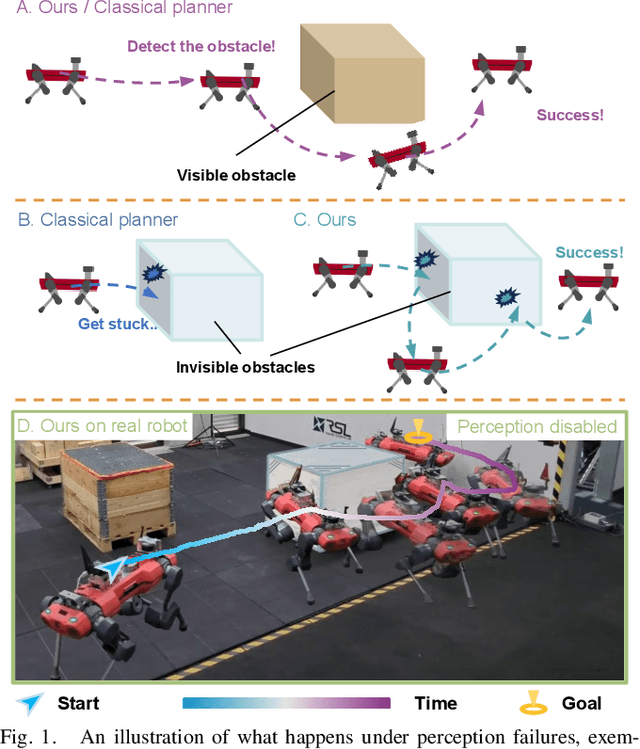

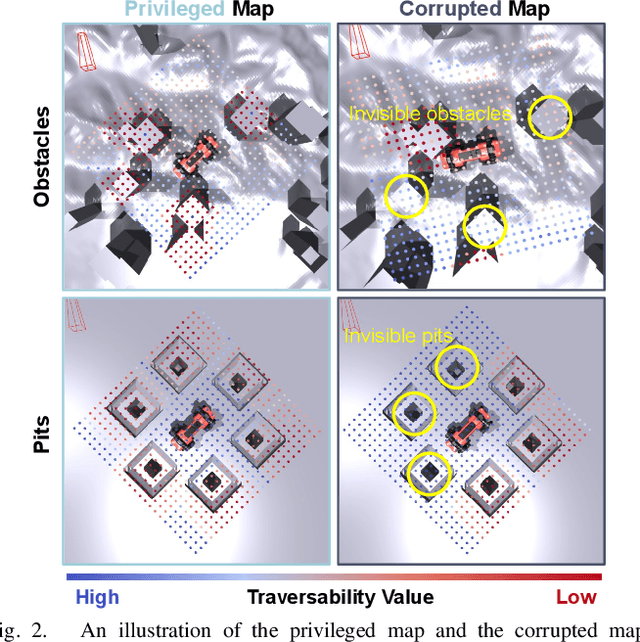

Abstract:Autonomous robots must navigate reliably in unknown environments even under compromised exteroceptive perception, or perception failures. Such failures often occur when harsh environments lead to degraded sensing, or when the perception algorithm misinterprets the scene due to limited generalization. In this paper, we model perception failures as invisible obstacles and pits, and train a reinforcement learning (RL) based local navigation policy to guide our legged robot. Unlike previous works relying on heuristics and anomaly detection to update navigational information, we train our navigation policy to reconstruct the environment information in the latent space from corrupted perception and react to perception failures end-to-end. To this end, we incorporate both proprioception and exteroception into our policy inputs, thereby enabling the policy to sense collisions on different body parts and pits, prompting corresponding reactions. We validate our approach in simulation and on the real quadruped robot ANYmal running in real-time (<10 ms CPU inference). In a quantitative comparison with existing heuristic-based locally reactive planners, our policy increases the success rate over 30% when facing perception failures. Project Page: https://bit.ly/45NBTuh.
Deep-learning-enabled Brain Hemodynamic Mapping Using Resting-state fMRI
Apr 25, 2022



Abstract:Cerebrovascular disease is a leading cause of death globally. Prevention and early intervention are known to be the most effective forms of its management. Non-invasive imaging methods hold great promises for early stratification, but at present lack the sensitivity for personalized prognosis. Resting-state functional magnetic resonance imaging (rs-fMRI), a powerful tool previously used for mapping neural activity, is available in most hospitals. Here we show that rs-fMRI can be used to map cerebral hemodynamic function and delineate impairment. By exploiting time variations in breathing pattern during rs-fMRI, deep learning enables reproducible mapping of cerebrovascular reactivity (CVR) and bolus arrive time (BAT) of the human brain using resting-state CO2 fluctuations as a natural 'contrast media'. The deep-learning network was trained with CVR and BAT maps obtained with a reference method of CO2-inhalation MRI, which included data from young and older healthy subjects and patients with Moyamoya disease and brain tumors. We demonstrate the performance of deep-learning cerebrovascular mapping in the detection of vascular abnormalities, evaluation of revascularization effects, and vascular alterations in normal aging. In addition, cerebrovascular maps obtained with the proposed method exhibited excellent reproducibility in both healthy volunteers and stroke patients. Deep-learning resting-state vascular imaging has the potential to become a useful tool in clinical cerebrovascular imaging.
NeXtQSM -- A complete deep learning pipeline for data-consistent quantitative susceptibility mapping trained with hybrid data
Jul 16, 2021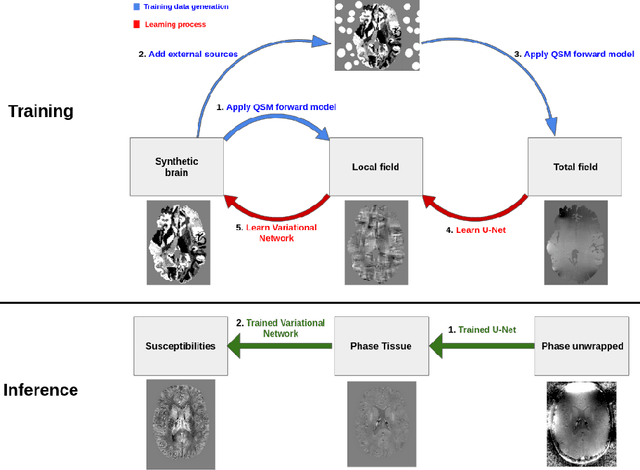

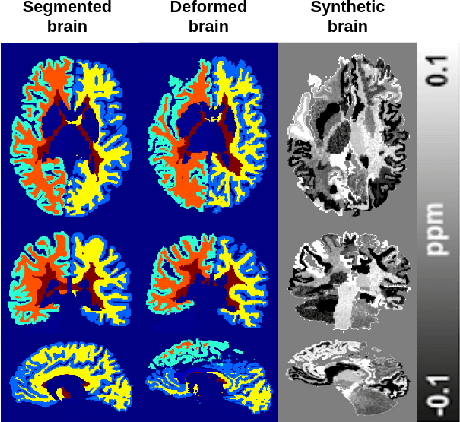
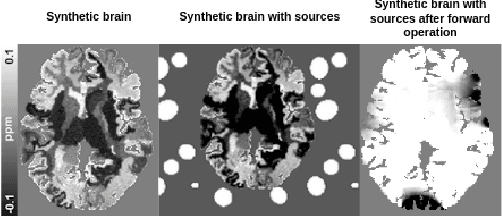
Abstract:Deep learning based Quantitative Susceptibility Mapping (QSM) has shown great potential in recent years, outperforming traditional non-learning approaches in speed and accuracy. However, many of the current deep learning approaches are not data consistent, require in vivo training data or do not solve all steps of the QSM processing pipeline. Here we aim to overcome these limitations and developed a framework to solve the QSM processing steps jointly. We developed a new hybrid training data generation method that enables the end-to-end training for solving background field correction and dipole inversion in a data-consistent fashion using a variational network that combines the QSM model term and a learned regularizer. We demonstrate that NeXtQSM overcomes the limitations of previous model-agnostic deep learning methods and show that NeXtQSM offers a complete deep learning based pipeline for computing robust, fast and accurate quantitative susceptibility maps.
Automatic Failure Recovery and Re-Initialization for Online UAV Tracking with Joint Scale and Aspect Ratio Optimization
Aug 10, 2020



Abstract:Current unmanned aerial vehicle (UAV) visual tracking algorithms are primarily limited with respect to: (i) the kind of size variation they can deal with, (ii) the implementation speed which hardly meets the real-time requirement. In this work, a real-time UAV tracking algorithm with powerful size estimation ability is proposed. Specifically, the overall tracking task is allocated to two 2D filters: (i) translation filter for location prediction in the space domain, (ii) size filter for scale and aspect ratio optimization in the size domain. Besides, an efficient two-stage re-detection strategy is introduced for long-term UAV tracking tasks. Large-scale experiments on four UAV benchmarks demonstrate the superiority of the presented method which has computation feasibility on a low-cost CPU.
DR^2Track: Towards Real-Time Visual Tracking for UAV via Distractor Repressed Dynamic Regression
Aug 10, 2020



Abstract:Visual tracking has yielded promising applications with unmanned aerial vehicle (UAV). In literature, the advanced discriminative correlation filter (DCF) type trackers generally distinguish the foreground from the background with a learned regressor which regresses the implicit circulated samples into a fixed target label. However, the predefined and unchanged regression target results in low robustness and adaptivity to uncertain aerial tracking scenarios. In this work, we exploit the local maximum points of the response map generated in the detection phase to automatically locate current distractors. By repressing the response of distractors in the regressor learning, we can dynamically and adaptively alter our regression target to leverage the tracking robustness as well as adaptivity. Substantial experiments conducted on three challenging UAV benchmarks demonstrate both excellent performance and extraordinary speed (~50fps on a cheap CPU) of our tracker.
Multi-resolution Super Learner for Voxel-wise Classification of Prostate Cancer Using Multi-parametric MRI
Jul 02, 2020



Abstract:While current research has shown the importance of Multi-parametric MRI (mpMRI) in diagnosing prostate cancer (PCa), further investigation is needed for how to incorporate the specific structures of the mpMRI data, such as the regional heterogeneity and between-voxel correlation within a subject. This paper proposes a machine learning-based method for improved voxel-wise PCa classification by taking into account the unique structures of the data. We propose a multi-resolution modeling approach to account for regional heterogeneity, where base learners trained locally at multiple resolutions are combined using the super learner, and account for between-voxel correlation by efficient spatial Gaussian kernel smoothing. The method is flexible in that the super learner framework allows implementation of any classifier as the base learner, and can be easily extended to classifying cancer into more sub-categories. We describe detailed classification algorithm for the binary PCa status, as well as the ordinal clinical significance of PCa for which a weighted likelihood approach is implemented to enhance the detection of the less prevalent cancer categories. We illustrate the advantages of the proposed approach over conventional modeling and machine learning approaches through simulations and application to in vivo data.
 Add to Chrome
Add to Chrome Add to Firefox
Add to Firefox Add to Edge
Add to Edge